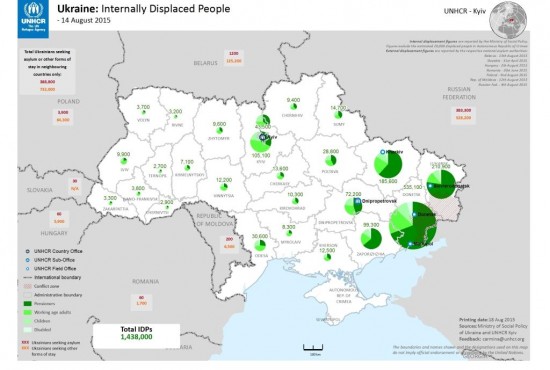Ukraine: the fate of displaced persons
di Matteo Tacconi, June 01 2016.

War in the Ukraine has caused about
1,5 million internally displaced persons.
The living conditions of
those who have fled the war zone in the east of the country are often
very difficult.
(This text is published as a
collaboration between OBC and Eurozine, part of the Eurozine-project
‘Beyond
conflict stories: Revealing public debate in Ukraine’ supported
by a grant from the Open Society Initiative in Europe within the Open
Society Foundations)
When military planes flashed through
the spring sky of Luhansk three years ago, and shots were heard in
some areas of the city, Elena Dyurugyna, 34, knew that things would
only get worse. She was right. Luhansk, Donetsk and the insurgent
areas in eastern Ukraine would shortly become the theatre of a war
between government forces and pro-Russian rebels.
At the time, Elena’s daughter was
two years old.
“I thought she should not see the war. I had work to
finish.
As soon as I was done I went to Kiev. I had no other choice.
I had studied in the capital for two years, so I knew it and liked
it. My husband had to stay in Luhansk during the worst of the
fighting because of his work. Then, in September of 2014, he joined
us”.
Elena is a photographer, and when she
left Luhansk she sold her camera and her equipment. She needed money
for the travel, to pay the rent and to feed her daughter.
At the
beginning, in Kiev, she worked in a MacDonald’s. She didn’t think
she would return to her old job, at least not soon.
However, she did
go back to taking photos. She specialised in photos of children, and
has kindergartens and schools among her clients. She takes portraits
and she does weddings.
Her studio is on the eleventh floor of a
building near the Livoberezhna underground station.
It is the same
address as the head office of the NGO, Krymskaya Diaspora, that
originally started to help those fleeing Crimea, the southern
peninsula annexed to Russia in March of 2014. They quickly widened
their action to help displaced persons from the crisis in Donbass,
which followed closely on that of Crimea.
NGOs
and Internally Displaced Persons
While attending a business course at
Krymskaya Diaspora, Elena Dyurugyna was given the money necessary to
buy back a camera and the necessary equipment.
Krymskaya Diaspora
made a studio available to her.
“The course was useful. It taught
me how to plan, to develop a strategy and how to promote myself. It
was also very competitive. We were two hundred and only seventeen of
us received funds”.
Krymskaya Diaspora is only one of the
NGOs, almost all of which are organised by volunteers and obliged to
work with donations, helping in Kiev and in the rest of the country
those internationally known as Internally Displaced Persons (IDPs).
That is, those who have left their homes and moved to other cities
and places in Ukraine because of the conflict. According to the
latest data relating to August 2015 from the UN High Commissioner for
Refugees (UNHCR), the number of IDPs in Ukraine is around 1,5
million.
Another one million have gone to Russia, according to the
authorities in Moscow.

Even the choice of where to go is
politically motivated.
This could not be otherwise in a country which
has been brutally divided since the Maidan uprising. Those who cross
the border feel an empathy for Russia, and do not trust the
government in Kiev. “Those who leave the area under the control of
the latter, make an informed choice for Ukraine, whereas crossing
into Russia would be easier”, says Lesia Lytvynova, co-founder of
Frolivska 9/11, another NGO helping displaced persons.
Their life is not easy. “About two
years ago, the government passed a law to protect their social rights
and to initially allow them a financial contribution”, states Olga
Semenova, from the Job Centre for free people, another NGO helping
the IDPs. “However, this is bound by technical and bureaucratic
steps which, in reality, make it difficult to function. These people
are asked to produce documentation, which mostly they do not have.
Therefore, our task is to defend their rights to health services, to
work, to kindergarten and to study”.
Resettlement
in Kiev
Employment is the main theme of the
organisation for which Olga Semenova works, as indicated by the name.
“Of the more than 15,000 people who contacted our NGO in our first
two years of activity, a third have found work. We have 3,000
companies listed in our database. We have also organised professional
courses for 5,500 people and allowed fifty startups to get going”.
To act as a bridge between displaced
people and companies is in itself hard work. Even more so in a
situation such as this, marked by a deep depression. In 2015, the
country lost 9,9 GDP points. Also “many of the displaced persons
are miserable, frustrated. Out of ten who turn to us, an average of
only three are motivated”, Natalia tells us.
She works at the Job
Centre for free people answering the calls coming in on the specially
created number.
Frustration feeds on the scarcity of
work opportunities, and on a sense of disorientation, having had to
leave one’s own land. Resettlement in Kiev is not always easy.
“At
the beginning, local people were supportive towards these people
arriving without anything. They were willing to give, sometimes even
to give hospitality. But as time passed things gradually changed. The
state did not take all the responsibility it should have taken. The
management of the displaced persons fell on the local communities”,
says Lesia Lytvynova.
The Frolivska 9/11 storeroom is
connected to the road by a window. Anyone who wants can leave food,
clothing and toys. A couple in their sixties passes. They have a sack
with them from which they take out something for the refugees. They
still give.
SOURCE: Balcanicaucaso


